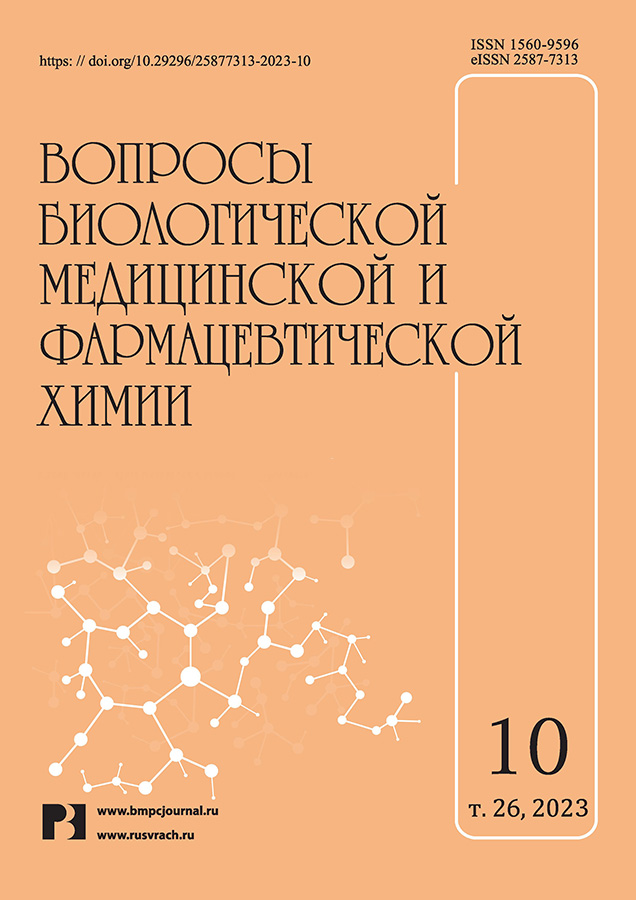Investigation of the biological activity of mixed-ligand complexes in relation to conditionally pathogenic strains
- Authors: Plotnikova Y.A.1, Barysheva E.S.1, Baranova O.V.1, Davydova O.K.1
-
Affiliations:
- Orenburg State University
- Issue: Vol 26, No 10 (2023)
- Pages: 32-37
- Section: Biological chemistry
- URL: https://journals.eco-vector.com/1560-9596/article/view/621438
- DOI: https://doi.org/10.29296/25877313-2023-10-05
- ID: 621438
Cite item
Abstract
Relevance. Flavonoids represent the largest group of natural molecules with antibacterial action, which can be explained by aggregation of bacterial cells and damage to the bacterial membrane. Modification of antimicrobial drugs with flavonoids may become a promising technique in the fight against antibiotic resistance, since the presence of complex structural complexes in the composition will help hide or reduce the recognition of antibacterial substances by bacteria.
The purpose of the work: To assess the change in morphometric parameters of bacterial cells of P. aeruginosa under the combined effect of antibacterial drugs and flavonoids of medicinal plant raw materials.
Material and methods: The object of the study were strains of R. aeruginosa grown on meat-peptone agar, which were affected by complexes of flavonoids isolated from Dianthus and Folia eucalypti with antibacterial drugs fosfomycin and ceftazidime. Visualization of morphometric changes and physical characteristics of the object of study was carried out using AFM.
Results. Analysis of the experimental data obtained indicates that combinations of flavonoids with ceftazidime significantly reduced bacterial cell length by 5.5% (p<0.05) for Dianthus and by 13.02% (p<0.001) for Folia eucalypti. The combination of these phenolic extracts of Dianthus and Folia eucalypti with fosfomycin was characterized by significantly significant increases in length by 28.86% (p≤0.001), a decrease in width by 11.03% (p≤0.01) and height by 55.91% (p≤0.001) in the case of Dianthus, and a decrease in length by 5.5% (p≤0.05) and a height of 55.38% (p≤0.001) for Folia eucalypti. Thus, significantly significant changes in the morphometry of the bacterial cell were observed for all samples in comparison with the control.
Conclusions: The data obtained confirm changes in the cell membrane of cells caused by the action of inhibitory components. The binding of antibacterial complexes with phospholipid groups changes the charge distribution across the membrane, disrupts internal membrane processes, inhibits the work of PSB, which causes a violation of peptidoglycan synthesis, and ultimately leads to a change in cell morphology.
Full Text
About the authors
Y. A. Plotnikova
Orenburg State University
Author for correspondence.
Email: shik8mail@mail.ru
Head of the Laboratory, Department of Biochemistry and Microbiology
Russian Federation, OrenburgE. S. Barysheva
Orenburg State University
Email: baryshevae@mail.ru
Dr.Sc. (Med.), Associate Professor, Head of the Department of Biochemistry and Microbiology
Russian Federation, OrenburgO. V. Baranova
Orenburg State University
Email: baranovaov@yandex.ru
Ph.D. (Biol.), Associate Professor of the Department of Biomedical Engineering
Russian Federation, OrenburgO. K. Davydova
Orenburg State University
Email: okdavydova@yahoo.com
Ph.D. (Biol.), Associate Professor of the Department of Biochemistry and Microbiology
Russian Federation, OrenburgReferences
- Tarahovsky Yu.S., Kim Yu.A., Yagolnik E.A., Muzafarov E.N. Flavonoid–membrane interactions: Involvement of flavonoid–metal complexes in raft signaling. Biochimica et Biophysica Acta (BBA) – Biomembranes. 2014; 1838(5): 1235–1246. doi: 10.1016/j.bbamem.2014.01.021.
- Wu Ting, He Mengying, Zang Xixi, Zhou Ying, Qiu Tianfu, Pan Siyi, Xu Xiaoyun. A structure–activity relationship study of flavonoids as inhibitors of E. coli by membrane interaction effect. Biochimica et Biophysica Acta (BBA) – Biomembranes. 2013; 1828(11): 2751–2756.
- Holina E.G., Bozdaganjan M.E., Strahovskaja M.G., Kovalenko I.B. Vzaimodejstvie kationnyh antiseptikov s kardiolipinsoderzhashhej model'noj bakterial'noj membranoj. Medicina jekstremal'nyh situacij. 2021; 3. URL: https://cyberleninka.ru/article/n/vzaimodeystvie-kation-nyh-antiseptikov-s-kardiolipinsoderzhaschey-modelnoy-bakterialnoy-membranoy (data obrashhenija: 27.06.2023).
- Zasowski E.J., Rybak J.M., Rybak M.J. The β-Lactams Strike Back: Ceftazidime-Avibactam. Pharmacotherapy. 2015 Aug; 35(8): 755–770. doi: 10.1002/phar.1622.
- Borisova M., Gisin J., Mayer C. Blocking peptidoglycan recycling in Pseudomonas aeruginosa attenuates intrinsic resistance to fosfomycin. Microb Drug Resist. 2014; 20: 231–237. doi: 10.1089/mdr.2014.0036.
- Pietta P.G. Flavonoids as antioxidants. Journal of Natural Products. 2000; 63(7): 1035–1042
Supplementary files







